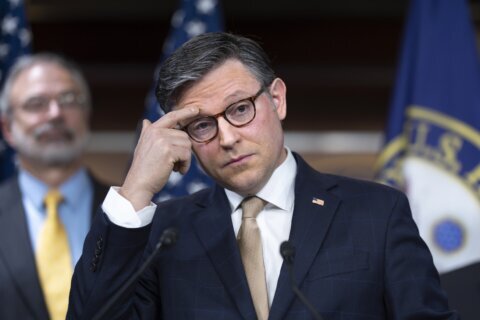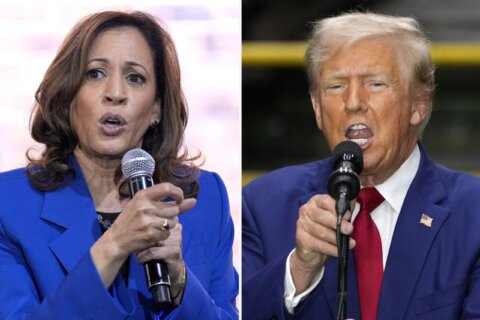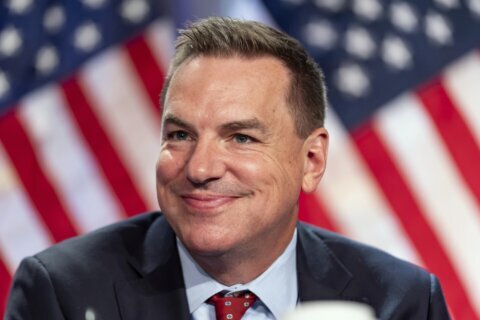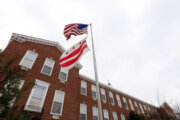WASHINGTON (AP) — Vice President Kamala Harris was asked this week if she thought Donald Trump was a fascist, and she replied, “Yes, I do.” She subsequently called him the same thing herself, saying voters don’t want “a president of the United States who admires dictators and is a fascist.”
But what exactly is a fascist? And does the meaning of the word shift when viewed through a historical or political prism — especially so close to the end of a fraught presidential race?
Here’s a closer look:
What is fascism?
An authoritarian, ultranationalist political ideology and movement. It is often associated with the far right and characterized by a dictatorial leader who uses military forces to help suppress political and civil opposition.
History’s two most famous fascists were Nazi chief Adolf Hitler in Germany and Italian dictator Benito Mussolini. Known as Il Duce, or “the duke,” Mussolini headed the National Fascist Party, which was symbolized by an eagle clutching a fasces — a bundle of rods with an axe among them.
At Mussolini’s urging, in October 1922, thousands of “Blackshirts,” or “squadristi,” made up an armed fascist militia that marched on Rome, vowing to seize power. Hitler’s Nazis similarly relied on a militia, known as the “Brownshirts.” Both men eventually imposed single-party rule and encouraged violence in the streets. They used soldiers, but also fomented civilian unrest that pit loyalists against political opponents and larger swaths of everyday society.
Hitler and Mussolini censored the press and issued sophisticated propaganda. They played up racist fears and manipulated not just their active supporters but everyday citizens.
Today, the term fascism has taken on a looser political definition and is often evoked as a catch-all for efforts to spread oppression and racism — as well as to decry dictators or leaders who embrace totalitarian tactics.
It is not just the left that has used the term, denouncing a push rightward in the U.S. and in many parts of the world. Some conservatives decried lockdowns imposed during the coronavirus pandemic as “fascist.”
What are other historical examples of fascism?
Hitler and Mussolini are its two biggest names, but it gets murkier from there.
Does military dictator Augusto Pinochet’s 17-year, ironfisted rule in Chile qualify? What about Indonesian strongman Suharto or Spain’s Francisco Franco? Were the regimes of Ferenc Szálasi in Hungary and Brazil’s Plínio Salgado fascist? Where does American neo-Nazi leader David Duke fit?
Indeed, critics sometimes describe modern U.S. extremist groups — including movements that have cheered Trump, like the Proud Boys — as fascists or neo-fascists. Those labels may be more steeped in political ideology than clear historical parallels.
Why is Harris calling Trump a fascist?
The vice president has long criticized Trump as being mentally unstable and not a true believer in, or defender of, the nation’s founding democratic principles.
She notes that Trump suggested he’d deploy the military to target political opponents, including people he has decried as the “enemy from within.” The former president has long talked about attacking his enemies and declared to his supporters that he would be their “retribution.”
“He’s talking about the American people. He’s talking about journalists, judges, nonpartisan election officials,” Harris said Wednesday night at a CNN town hall.
Trump has threatened to take action against television networks and news organizations for coverage he deems unfavorable. And, when now-President Joe Biden challenged him during a 2020 debate to denounce the Proud Boys, Trump replied: “Proud Boys, stand back and stand by.”
A mob of pro-Trump supporters stormed the U.S. Capitol on Jan. 6, 2021, seeking to overturn Trump’s loss to Biden after Trump gave a speech propagating falsehoods about the election and exhorting the crowd to “fight like hell.” Among the people imprisoned in connection with Jan. 6 was the leader of the Proud Boys, accused of orchestrating a failed plot to keep Trump in power.
Harris has been building toward the characterization. During an interview with her in Detroit on Oct. 15, radio host Charlamagne Tha God, said Trump was increasingly embracing fascism and asked, “Why can’t we just say it?” “Yes, we can say that,” Harris replied.
Then, Trump’s longest-serving former chief of staff, retired Marine Corps Gen. John Kelly, warned that the former president meets the definition of a fascist. He said Trump, while in office, suggested that Hitler “did some good things,” and that Trump valued personal loyalty above the Constitution.
Trump’s campaign has accused Kelly of lying and brushed aside Harris’ criticism, with spokesperson Karoline Leavitt responding, “Kamala will say anything to distract from her open border invasion and record high inflation.” Trump has described Jan. 6 as a “day of love.”
Trump himself rejected the fascist label in an interview Thursday with Fox News.
“Everyone knows that’s not true,” he said. “They call me everything until something sticks.”
How do experts on fascism view Trump?
They are divided.
Robert Paxton, a Columbia University professor emeritus who wrote “The Anatomy of Fascism,” has cited the Jan. 6 attack as evidence of Trump’s fascism.
“It’s bubbling up from below in very worrisome ways, and that’s very much like the original fascisms,” Paxton told The New York Times Magazine in a piece published this week. “It’s the real thing. It really is.”
Some do not see Trump as meeting the classic historical definition of a fascist, but rather increasingly moving toward politics that have fascist tendencies.
David Kertzer, a Brown University professor and Italian historian, said he was “a little horrified” to hear Harris call Trump a fascist given the term’s “historical resonance.” He said there are some similarities, including “mass movement, a cult of the strongman.” He noted that Trump sometimes juts out his chin, though he isn’t prone to tearing off his shirt and bare his chest, like Mussolini did.
Kertzer said that fascism involved “a one-party state, a banishing of all opposition newspapers and jailing people who disagreed,” and that, while Trump has talked about jailing opponents, he’s not moved toward embracing other key facets of the movement.
“There are certain echoes, but in terms of turning the Republican Party into a one-party state, that seems rather farfetched at the moment,” said Kertzer, author of “The Pope and Mussolini: The Secret History of Pius XI and the Rise of Fascism in Europe.”
David Clay Large, a senior fellow at the University of California, Berkeley’s Institute of European Studies, said “the alarm bells now going off may be somewhat overblown.”
“Our democratic institutions, however beleaguered, remain much stronger than those of the European nations that turned fascist in the ‘20s and ’30s,” Large said. Still, he added, there would be “a real danger to these institutions” in a second Trump presidential term.
The rise of far-right parties across Europe and Trump’s control of the GOP, Large said, carves out “an entirely new situation: The center cannot hold as it once did.”
Add to that mix social media, which in the digital age mirrors the use of propaganda, amping up emotions and division, he said.
“Where everyone’s an expert, we’ve lost respect for factuality, objectivity, and actual expert opinion,” Large said.
—- Kellman reported from London.
Copyright © 2025 The Associated Press. All rights reserved. This material may not be published, broadcast, written or redistributed.







